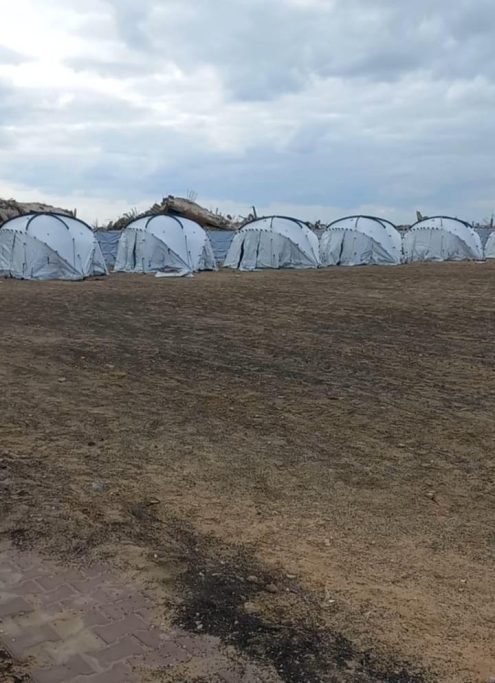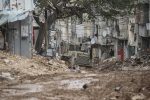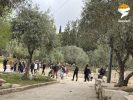The brutal Israeli aggression against Gaza that went on for more than a year caused layers of suffering to the Palestinians, one of which is forcible displacement.
On the 19th of January 2025, the ceasefire agreement finally came into effect in the enclave after great efforts made by negotiating delegations.
The agreement terms included allowing displaced people in the southern Gaza Strip to return to the north in the first phase of the ceasefire.
Longing for a sense of home has been the most prevailing feeling for the people in Gaza. Despite the deep grief, celebrations were held all over the Strip once the truce was declared.
Hope of return
“I will hug the walls of my house when I return to the north!” had been a common saying of the people of Gaza to articulate their urge to settle down and find peace after long months of suffering without life demands, most importantly housing.
Not only did displaced people follow the news of the heavy bombardment in the northern Strip, but they also frequently asked for updates about their houses by staying in touch, whenever possible, with neighbors or relatives who managed to stay in the north.
“Our home is still standing!” Some people celebrated as the ceasefire was finally reached, waiting wholeheartedly for the moment they arrive to use it as a shelter for them and all their relatives whose homes had been destroyed.
Arriving to the north
On the morning of the 27th of January, tens of thousands of Gaza’s people journeyed north, on foot.
Making such a journey amid tens of millions of tons of rubble left in Gaza, the returnees came face to face with the horror of the destruction caused by the massive Israeli bombardment of Gaza.
For people who couldn’t get any bit of news about their homes, who are greater in number, they had to deal with the question of: “Where to return?”
When they ultimately reached ‘home’, they were left with generally expected choices: a partially destroyed home, completely destroyed home, or burnt home.
Another misery is returning to the horrible sight of a worn-out neighborhood whose landmarks are totally obliterated after the heavy bombardment had wiped it out. There, no houses or neighborhoods are recognized for the returnees.
In all the aforementioned cases, disappointment and grief controlled. Crying over the remnants of their homes, youths and elderlies tearfully sang the well-known Palestinian song, “I once had a home there!”
Temporary shelters
Realizing that even temporary housing aid such as caravans or tents wouldn’t be allowed into the Strip until the first phase of the ceasefire agreement was reached, people had to create their own temporary shelters.
Nearly a month has passed since the displaced returned to the north of the Gaza Strip. Since they took that tiring journey back, they have been working hard to create a shelter out of anything that remained in their bombed house.
With the bare minimum of cost, making a temporary shelter with one room left in the partially damaged home requires repairing broken windows and replacing walls with sheets. That won’t cost much as some furniture or belongings might be found, if not vandalized or robbed due to the ground invasions.
However, other houses, greatly damaged or burnt, required much work to be restored with cheap and available material such as asbestos plates, sheets, or nylon pieces, all of which don’t prevent heavy rain or windy weather to penetrate throughout the place.
Therefore, since the day of arriving home, most of the returnees haven’t settled yet. Lifting rubble, searching for stones, fixing holes, covering broken walls, or debating whether to stay in home remnants or to set a tent have been the daily tasks.

Finding alternatives
For the people whose homes or neighborhoods were completely razed, there was no room for making repairs. A good choice for those who could afford it was renting a place: a house, room, warehouse, or any vacant place.
Besides being called “rich”, a person returning to any neighborhood in northern Gaza Strip looking for a one-room house with a bathroom and consistent water supply was also labeled “insane”.
With about 297,000 housing units partially damaged and 87,000 units totally destroyed, in addition to other 156,423 buildings destroyed since the 7th of October, 2023, where to rent, then?
Therefore, having a relative who still has a standing home was a blessing that all the people who lost their houses wished to receive.
Temporarily, relatives who had a home in the north would suffice their own family with one room, welcoming families of their siblings or cousins in other rooms.
With the huge number of destroyed housing units and buildings, that choice was barely available, leaving most of the people with the only available yet detested solution: setting tents near the rubble of their homes.
In spite of the fact that the people of Gaza tried to stay grateful with any condition of shelter they are left with, the return was yet another chapter of displacement. The destroyed infrastructure makes obtaining life essentials, most importantly water, an impossible task.
Until constructing materials, combustible substances, and other heavy equipment are finally allowed into the enclave, a decent shelter for most of us is a postponed wish.
-Amna Shabana is a Gaza-based journalist. She contributed this article to the Palestinian Information Center.











